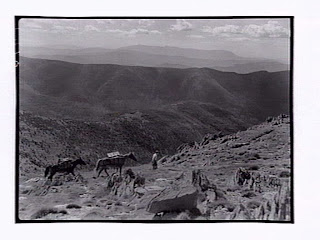Below is a series of paired photos that I'm using to look for obvious changes in the 'woodiness' of alpine ecosystems in the Victorian Alps over the last few decades that might help us understand how alpine vegetation is responding to global change drivers such as climate change and fire.
Theory predicts that with climate warming - and there has already been a 0.8 deg C increase in Australian mountains over the last century - that alpine treelines should migrate upslope to higher elevations, while grassy communities might become shrubbier. Where low temperatures might have limited woody growth in the past, warming eases or relaxes those environmental filters.
First, I searched the Trove website to find historical photos that show mountain landscapes - this is the archive of the National Library of Australia. Mountains are good places to look for vegetation change over time using old photos because it is often easy to relocate the approximate location where the original photo was taken. You can match up ridgelines, rock outcrops, mountain summits etc and get a pretty good approximation of the original location. This is important if you want to re-photograph that same view from which to then make comparisons over time.
While it sounds easy, many of the original shots are too grainy to use, or there is a horse / cow / cattleman obscuring the really important bit of the landscape you want to see. Eventually, however, I found about 40 photos across eight mountain regions that looked promising for comparative purposes. I went up to the mountains last summer and tried my hardest to line up the old shot so I could take something as close as possible to the original. Surprisingly it is really difficult to get the exact same shot, although I think I succeeded some of the time!
While the interpretations are qualitative rather than quantitative at this stage, it is clear that there has been very little obvious change in the woody component of the landscape over a 60-100 year period. This was somewhat surprising given the substantial regional warming that has occurred over the last few decades. There have also been several fires in the alps over the last 80 years and these are generally expected to favour shrub establishment and hence, an increase in heathy vegetation in grasslands. My overriding impression is that treelines have not moved much. Total tree cover is higher in some photos, but this is mainly due to resprouting after fire rather new plants 'infilling' the landscape. Shrub cover is higher in some places but not others. Hence, structural transformation is not apparent.
I hope you enjoy these comparisons. If you think you have photos that might be useful to examine structural changes in alpine areas of Australia, I'd be really keen to hear from you (J.Morgan@latrobe.edu.au). Even better, how about you go up and take a shot of the same view and let me know whether you think the alpine is transforming!
 |
| Looking west towards The Bluff (in 1953 and 2012) from Mt Eadley Stoney. Snow Gums appear more common now. Low heathland still dominates much of the area. |
 |
| On the ridgeline towards Mt Loch (from Mt Hotham): 1946 and 2012 Note: trees seem more prominent in both the foreground and mid-ground where grassy patches were previously more prominent |
 |
|
Mt Feathertop 1913 and 2013. Note very little difference in position of upper treeline |





No comments:
Post a Comment